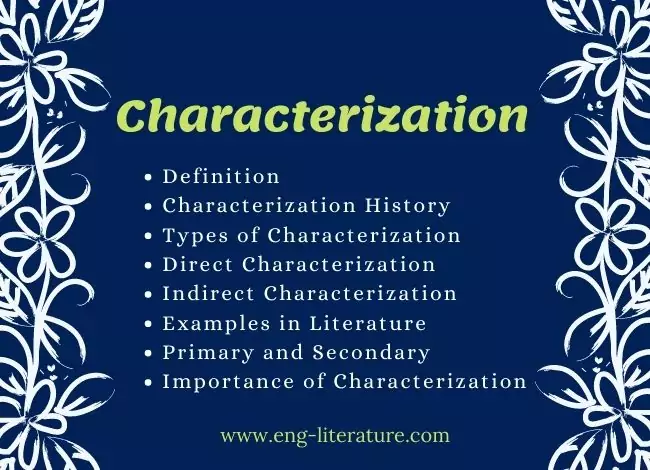Characterization in Literature
Definition
Characterization broadly refers to the description development of characters. Few scholars consider it as the representation of persons in ‘narrative and dramatic work’. It includes direct methods like the attribution of qualities in description or commentary, and indirect (or ‘dramatic’) methods inviting readers to infer qualities from characters’ actions, speech or appearance.
Wikipedia defines the term,
“Characterization or characterisation is the art of creating characters for a narrative, including the process of conveying information about them.”
It may be employed in dramatic works of art or everyday conversation. Characters may be presented by means of description, through their actions, speech, or thoughts.
History
The term came into existence in mid 19th century. Aristotle promoted the primacy of plot over characters, that is a plot-driven narrative, arguing in his Poetics that tragedy “is a representation, not of men, but of action and life.” This view was reversed in the 19th century, when the primacy of the character, that is a character-driven narrative, was affirmed first with the petty bourgeois realist novel, and increasingly later with the influential development of psychology.
Types of Characterization
There are two prominent ways an author usually conveys information about a character:
Direct or explicit
When an author literally tells the audience what a character is like, it is direct or explicit characterization. This may be done the narrator, another character or by the character him or her.
Also Read:
Direct Characterization Examples in Literature
The character of Elizabeth in Pride and Prejudice by Jane Austen is a superb example of direct characterisation. Austen uses direct characterization in this passage to describe Elizabeth through the eyes of Mr. Darcy, who at first sight rejects her saying ‘not so handsome’ but ultimately marrying her at the end.
J.K. Rowling applies direct characterization with the character of Harry Potter in Harry Potter and the Sorcerer’s Stone
Indirect or implicit
In the implicit or indirect characterisation the audience must deduce for themselves what the character is like through the character’s thoughts, actions, speech (choice of words, way of talking), looks and interaction with other characters, including other characters’ reactions to that particular person.
Indirect Characterization Examples in Literature
Harper Lee characterizes Atticus in To Kill a Mockingbird in order to describe one of Scout’s neighbors-Mrs. Dubose.
William Shakespeare in his Sonnet No. 130 (My Mistress’ Eyes are Nothing Like the Sun) uses indirect characterization to describe his mistress (Dark Lady).
Direct Vs Indirect Characterization
In short we can say that direct characterisation tells the reader about a character; indirect characterisation shows a character in action and leaves the reader to infer the rest.
Primary and Secondary Characterization
However, there are two other types of characterization that includes primary and secondary characterization. The primary characters drive a story, carry the weight of a story, and so forth. As they do that work, the primary characters exhibit a depth or complexity that allows the reader to see changes or realizations in them as a result of the events of a fiction. (Another way to say this is that primary characters are generally dynamic, or changeable, whereas secondary characters are generally static, or unchanging.) Many critics consider all characters as either primary or secondary, while some add a third category of something like “extras” in films–the often nameless characters that add functional realism but nothing else.
Importance of Characterization
It plays a crucial role in description and narration, because it helps readers to more clearly understand the motifs and inward psyche of characters. Effective and skillful characterization works in harmony with setting and plot to make the readers connect on a more intimate level to a text.

Hello, Viewers! Besides being the Founder and Owner of this website, I am a Government Officer. As a hardcore literary lover, I am pursuing my dream by writing notes and articles related to Literature. Drop me a line anytime, whether it’s about any queries or demands or just to share your well-being. I’d love to hear from you. Thanks for stopping by!

Oh, a man after my own heart!!! I love literature. My dad was a book “collector” and my mother read books to my brothers and me. When my dad died, I took most of his library to the local high school. I kept my favorite books. My dad not only collected literature but science, math, and geography books. I look forward to reading more of your posts.
Extend my heartfelt love to you and your family for being the admirer of literature…Thank u
I am teaching gifted/advanced 6th graders about Characterization. Any good questions or prompts you would use? I want them to dig deep. We are beginning Historical Fiction next. Any help is appreciated or resource. Thank you!